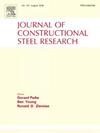Energy absorption characteristics and misalignment design for combined structures with compact units
IF 4
2区 工程技术
Q1 CONSTRUCTION & BUILDING TECHNOLOGY
引用次数: 0
Abstract
Individual structures have a limited capacity to improve energy absorption solely through geometric adjustments. Enhancing energy absorption through combined methods while maintaining response stability and cost-effective remains challenging. In the study, compact ring-shear structures with superior properties are combined; the energy absorption mechanism of combined structures with multiple compact ring-shear units (CRS) is explored. Impact tests and simulations reveal that increasing the number of identical units in a CRS induces a saturation effect, reducing the stability of energy absorption. A misalignment strategy is proposed to improve performances of the CRS by evenly distributing the peaks of impact force-displacement curves among units. This method significantly improves both energy absorption and response stability of the CRS. The optimal number of units is determined based on the ratio of overlap thickness to ring thickness, with a recommended ratio of approximately 0.5. The impact response of the CRS under oblique impacts and various array configurations is also evaluated, demonstrating stability across different conditions. The practical applicability of the misaligned CRS in confined-space brake systems is validated through design, testing, and simulation. Results show that the misaligned CRS achieves high energy absorption and low response fluctuation, making it suitable for engineering applications requiring efficient impact energy dissipation.
单个结构仅通过几何调整来提高能量吸收能力是有限的。在保持响应稳定性和成本效益的前提下,通过组合方法提高能量吸收能力仍具有挑战性。本研究将具有优异性能的紧凑型环剪结构组合在一起,并探讨了具有多个紧凑型环剪单元(CRS)的组合结构的能量吸收机制。冲击试验和模拟显示,增加 CRS 中相同单元的数量会产生饱和效应,降低能量吸收的稳定性。研究提出了一种错位策略,通过在各单元之间均匀分布冲击力-位移曲线的峰值来提高 CRS 的性能。这种方法大大提高了 CRS 的能量吸收和响应稳定性。最佳单元数是根据重叠厚度与环厚度之比确定的,建议比例约为 0.5。此外,还评估了 CRS 在斜向撞击和各种阵列配置下的撞击响应,证明了其在不同条件下的稳定性。通过设计、测试和模拟,验证了错位 CRS 在密闭空间制动系统中的实际应用性。结果表明,错位 CRS 可实现高能量吸收和低响应波动,适用于需要高效冲击能量消散的工程应用。
本文章由计算机程序翻译,如有差异,请以英文原文为准。
求助全文
约1分钟内获得全文
求助全文
来源期刊

Journal of Constructional Steel Research
工程技术-工程:土木
CiteScore
7.90
自引率
19.50%
发文量
550
审稿时长
46 days
期刊介绍:
The Journal of Constructional Steel Research provides an international forum for the presentation and discussion of the latest developments in structural steel research and their applications. It is aimed not only at researchers but also at those likely to be most affected by research results, i.e. designers and fabricators. Original papers of a high standard dealing with all aspects of steel research including theoretical and experimental research on elements, assemblages, connection and material properties are considered for publication.
 求助内容:
求助内容: 应助结果提醒方式:
应助结果提醒方式:


